Jan Piotrowski
at the First World War
On June 28, 1914 Archduke Franz Ferdinand, the heir to the Austro-Hungarian throne,
was killed in Sarajevo. One month later, on July 28, 1914 Austro-Hungary declared war against Serbia.
As far as on August 6. of the same year
also Germany, Russia, France and England were engaged in armed conflict already.
The First World War started.
Jan Piotrowski
was Polish and surely was not much moved with his Austro-Hungarian country.
But he was Kaiser Franz Joseph's subject. Nobody asked him of his opinion.
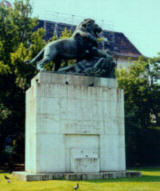 He was mobilized and sent to take part in defence of Fortress Przemyśl.
Perhaps he served there a fireman.
He was mobilized and sent to take part in defence of Fortress Przemyśl.
Perhaps he served there a fireman.
Przemyśl is a town in close neigborhood of Strachocina (ab. 30 miles from it).
Austrians built there a fortification considered to be the greatest one in modern Europe.
In September 1914 Russians took the successful offensive. They conquered large
part of Galicia.
The Fortress Przemyśl didn't fall but was under siege.
It fell after six months in March 1915.
Private Jan Piotrowski returned home.
In Down Town of Budapest, capital of Hungary there is a memorial devoted to
defenders of the Fortress Przemyśl. It shows a lion
(seems that it took pattern by the famous memorial in Greek Thermopylae).
From autumn of 1914 to early spring of 1915 Strachocina was under Russian occupation.
But in the beginning of May Austrians dislodged Russian Army, recaptured Przemyśl
and other Galician towns.
Private Jan Piotrowski was mobilized again.
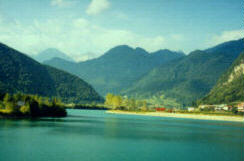 On May 24, 1915 Italy declared war against Austro-Hungary.
It meant for Austro-Hungary a new, 600 km long front line - from the
Steliva pass on the Austrian-Italian-Swiss border point, over Alps,
the Soca (in Italian: Isonzo) Valley, to the Adriatic Sea.
On May 24, 1915 Italy declared war against Austro-Hungary.
It meant for Austro-Hungary a new, 600 km long front line - from the
Steliva pass on the Austrian-Italian-Swiss border point, over Alps,
the Soca (in Italian: Isonzo) Valley, to the Adriatic Sea.
Private Jan Piotrowski and other Polish soldiers were sent to the Soca Region
in the Karst plateau
(see map - ab. 200 kB).
Surely they could see the blue belt of the Soca, reflecting green woods and vineyards
along the banks and rocks of distant Alps.
But they were not sent there for touring.
Austrians turned these landscapes into iron and concrete fortification.
In June battles started.
Italian forces advanced.
Most successfully in the Upper Soca Region.
Italians took Kobarid and then by June 1915 reached the top of Mt. Krn.
They stayed there all until the last Isonzo Battle in October 1917.
They were less successful on the Karst plateau.
In several bloody battles had made no material gain despite huge losses.
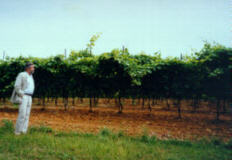 In 1915 there were:
In 1915 there were:
June 29. - July 7.: the 1st Battle of the Isonzo.
July 18. - August 3.: the 2nd Battle of the Isonzo.
October 18. - November 3.: the 3rd Battle of the Isonzo.
November 18. - December 2.: the 4th Battle of the Isonzo.
We don't know in which of these battles Jan took part.
He was killed during the last of them, on November 21, 1915.
In the only document we have on his death the battle is called Battle at Hudi Log.
This should be cleared up yet but it seems to be manifest that the Battle at Hudi Log
and the 4th Battle of the Isonzo are the same.
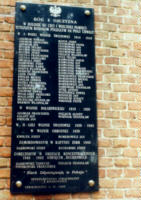 We know from Jan's widow Paulina
that Jan was shot in his belly with a dum-dum bullet.
He died in the same day. One of his friends wrote a letter to his widow.
According to her the letter was very touching. Unfortunately it got lost.
We know from Jan's widow Paulina
that Jan was shot in his belly with a dum-dum bullet.
He died in the same day. One of his friends wrote a letter to his widow.
According to her the letter was very touching. Unfortunately it got lost.
Jan was not the only inhabitant of Strachocina that lost his life in the War.
The harvest of death was great.
At a commemorative table on the wall of the parish church in Strachocina one can read
as much as 48 names (much more than 10% of all soldiers from Strachocina!).
4th Battle of the Isonzo was not the last one.
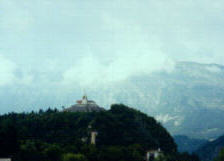 The last one was the famous 12th Isonzo Battle
that began on October 24, 1917, and was fought by intermittent
stages until November 9, 1917.
The last one was the famous 12th Isonzo Battle
that began on October 24, 1917, and was fought by intermittent
stages until November 9, 1917.
It was greatly successful for Austro-German troops.
Italian army was forced to retreat from the entire Isonzo battlefield. As far as to Piave river.
The 12th Battle of the Isonzo was called later "the marvel at Kobarid". Is known
as the first so called "blitz krieg".
The story told by Ernest Hemingway in his novel "Farewell to arms" takes place just in
Kobarid (in Italian: Caporetto), just during the 12-th Isonzo Battle.
In battles of the Isonzo more than 500 thousand soldiers lost their lives. Together with
civilians they make about one million dead.
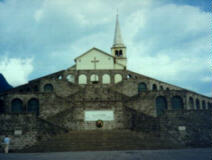 Several hundred (!) Austro-Hungarian and Italian cemeteries were scattered around on
the territory of the Isonzo Front.
Several hundred (!) Austro-Hungarian and Italian cemeteries were scattered around on
the territory of the Isonzo Front.
In the times between World War I and World War II, the Italians re-arranged their cemeteries.
They collected the mortal remains of their dead soldiers and deposited them
into three central charnel houses along the Isonzo Front. They are at Sredipolju, Oslavia
(now in Italy) and at Kobarid, Slovenia.
In the memorial charnel house at Kobarid, there are mortal remains of 7014 Italian soldiers,
which were brought there from the Upper Soca Region.
On the top of it there is an older church dedicated to St. Anthony,
visible at a long distance.
In Kobarid there is a famous
Museum of the Isonzo Battles too.
(To learn more about the I World War and the battles of the Isonzo see also
WW I Links Central,
pages of The Great War Society,
The Battles of the Isonzo, 1915-17,
K.u.K Infantry Regiment No.63,
First World War.com - "The War To End All Wars".)
Expedition of Władysław and Tadeusz to Hudi Log, to find Jan's grave
We knew the name of the place where our grandfather Jan was killed from a court document
but didn't know where it was. We could only guess that it was somewhere in Italian Alps.
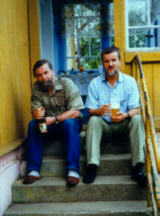 No wonder that Jan's grandson Tadeusz
when being (for a short space) in Slovenia in September of 1996 went there
(to Jesenice, Krajnska Gora and further).
He found that there is no Hudi Log in Alps and that the proper location is Lower Socia Region,
in the Karst plateau, near Nova Gorica. In 1996 he had not enough time to go there.
No wonder that Jan's grandson Tadeusz
when being (for a short space) in Slovenia in September of 1996 went there
(to Jesenice, Krajnska Gora and further).
He found that there is no Hudi Log in Alps and that the proper location is Lower Socia Region,
in the Karst plateau, near Nova Gorica. In 1996 he had not enough time to go there.
The nearest occasion appeared summer of 1999.
He got his brother Władysław to take part in
the expedition. Both wives were against it. Regardless of this they went there but taking
the opinion of their women
into consideration they cut down the time of their excursion to the shortest possible.
The picture shows them rather discontented with this, sitting at stairs of the family
house in Strachocina (and drinking bier).
They went to Slovenia by a small car Daewoo Tico (Tadeusz's). Made ab. 1500 miles in three days
(June 25 - 27). A driver was Tadeusz.
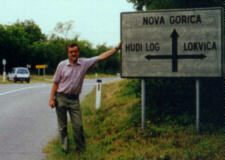 They crossed Polish-Slovakian border in Barwinek, Poland, Slovakian-Hungarian border
in Midasnemeti, Hungary and went to Budapest. Toured around the city for a couple of hours
(it was a very hot day not good for sightseeing).
Found there a memorial devoted to defenders of the Fortress Przemyśl (and shot a photo).
They crossed Polish-Slovakian border in Barwinek, Poland, Slovakian-Hungarian border
in Midasnemeti, Hungary and went to Budapest. Toured around the city for a couple of hours
(it was a very hot day not good for sightseeing).
Found there a memorial devoted to defenders of the Fortress Przemyśl (and shot a photo).
Then they went (along Balaton Lake) to Slovenian border.
Spend the night in a hotel at Lendi, Hungary (it was rather mean though the best in
this little border town).
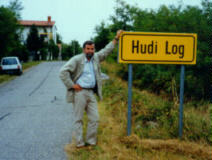 Next day they went to Slovenia. Across it to the Karst plateau.
There they found the way to Hudi Log. Visited the village.
Next day they went to Slovenia. Across it to the Karst plateau.
There they found the way to Hudi Log. Visited the village.
Pictures show them in it and in its vicinity.
They walked around the village (a couple of houses only). Tried to speak with inhabitants
(Polish and Slovenian languages are rather similar, knowing Russian language helped very much).
Alas inquired persons didn't know about any cemetery of soldiers from the First World War.
They told about some memorial in Nova Vas only.
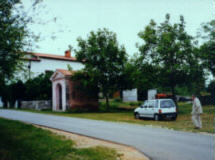 Władysław and Tadeusz had with them two candles and a bunch of corn and wild flowers from the
field that Jan once ploughed (now it belongs to Jan's granddaughter
Alina).
They reflected on where to put them.
Władysław and Tadeusz had with them two candles and a bunch of corn and wild flowers from the
field that Jan once ploughed (now it belongs to Jan's granddaughter
Alina).
They reflected on where to put them.
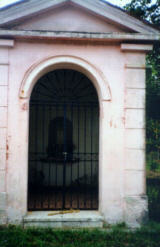 They found in the village a wayside shrine of the St. Mary (see)
and put flowers and corn at its front (see). They made up their minds to lit candles
on the memorial in Nova Vas or on the charnel house in Kobarid.
They found in the village a wayside shrine of the St. Mary (see)
and put flowers and corn at its front (see). They made up their minds to lit candles
on the memorial in Nova Vas or on the charnel house in Kobarid.
Then they went to Nova Vas.
It proved that the memorial had nothing to do with grandfather Jan.
It was devoted to Hungarian soldiers killed in action.
Going across the Karst plateau they saw little villages of old houses made of stone surrounded
by grape plants, by fig, wallnut and palm trees. They saw vineyards and
wood on steep hills.
They guessed that the most likely the mortal remains of their grandfather lie
somewhere there in this beautiful landscape.
Without any grave. They thought of lighting candles
in the neighborhood of Hudi Log at any place in the wood or in front of a traffic signal with name of
the village they had photographed.
They knew that in the charnel house in Kobarid
there were remains of Italian soldiers (that killed their grandfather). Nevertheless they
made their minds to go to Kobarid. To investigate this.
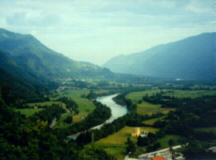 They went along Soca Valley. Wandered over to winding mountain roads (surfaced with broken stone)
of Cepovan Valley at Trnovski Mountains.
They went along Soca Valley. Wandered over to winding mountain roads (surfaced with broken stone)
of Cepovan Valley at Trnovski Mountains.
At last reached Kobarid.
They climbed (by car) steep hill where the charnel house was erected.
Looked down. To the Soca Valley. It was a really beautiful sight to see.
It showed that on walls of the charnel house there were boards with names of
Italian soldiers that lied there.
But there were also anonymous remains. Writings on some boards said:
"MILITI IGNOTI" that means (in Italian) "UNKNOWN SOLDIERS".
Perhaps they were Italians too, but maybe ... ? Maybe one of them was (by chance) not Italian but
killed by Italians their opponent - private Jan Piotrowski?
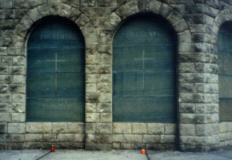 Władysław and Tadeusz made up their minds that they couldn't find better place
to burn their candles.
So they lighted them in front of two such boards. What they were to do?
Władysław and Tadeusz made up their minds that they couldn't find better place
to burn their candles.
So they lighted them in front of two such boards. What they were to do?
It was already late afternoon, five p. m. Bells rang at belfry described by Hemingway.
They stood for a while yet, than got into car.
Went back across Slovenia. Spent night in a hotel at Lendi, Hungary again.
Next day in the evening they were in Strachocina.
They plan to go to Socia Valley in the future.
Maybe grandfather Jan has a grave yet ... ?
In November 1999 a Professor from Rijeka, Kroatia told Tadeusz about a cemetery in Redipuglia, Italy.
It turned that there is the great Military Memorial of Italian and Austro-Hungarian soldiers.
The place is situated near Trieste, Italy i.e. near Hudi Log. It sounds very promissing ...
And the Valley is so beautiful ...
 He was mobilized and sent to take part in defence of Fortress Przemyśl.
Perhaps he served there a fireman.
He was mobilized and sent to take part in defence of Fortress Przemyśl.
Perhaps he served there a fireman.










